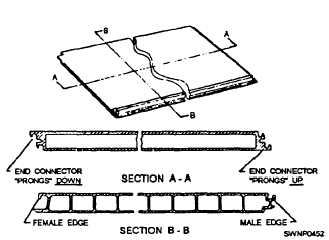CHAPTER 11 PRE-ENGINEERED STRUCTURES: SHORT AIRFIELD FOR TACTICAL SUPPORT
The Short Airfield for Tactical Support (SATS) is a rapidly constructed expeditionary airfield that can be erected near a battle area to provide air support for amphibious Marine forces. In any land-and-sea military/contingency operation, the rapid assembly of a temporary airfield provides ground units with the distinct advantage of continuous air support on foreign soil. Because of this, the Marine Corps has been trying several types of expeditionary airfields since early in World War II. Initial research used wooden planking for the runway surface. Later, during the Korean Conflict, aircraft actually landed on pierced steel mats, known as "Marston matting."
One of the more important breakthroughs in SATS research was the development of Short Expeditionary Landing Field (SELF). SELF, a bulky predecessor of SATS, was a 4,000-foot runway that served as the landing area. In earlier expeditionary arresting operations, the Marine Corps had been successful with the M-2 Mobile Arresting Gear (MOREST). However, the weight of this gear (74,000 pounds) decreased its usefulness as a portable unit.
In 1956, the Commandant of the Marine Corps established exact specifications for the development of a portable expeditionary airfield. This proposed airfield was to be 1,000 feet long, construction completed in 5 days, and capable of accommodating one squadron of aircraft for 30 days. Additionally, the Marine Corps required that the field be designed to allow both launch and recovery (arresting) operations. These standards included the development of a land-based catapult and lighter arresting gear to replace the M-2 MOREST. In 1958, the runway specification was expanded to 2,000 feet and received official SATS designation. However, because the catapult and arresting gear are no longer available in the ABFC (Advanced Base Functional Components) System, they are not discussed in this chapter.
Because Steelworkers can be assigned to crews assigned to place airfield matting, we will discuss the important parts of SATS. Also, the proper placement procedures for AM-2 matting are discussed and information is also provided on the installation and repair and removal of AM-2 mating.
PARTS OF SATS FIELD
A SATS field incorporates numerous parts. We will not attempt to cover all the parts of a SATS installation but will cover enough to make you familiar with the function of each of the major parts that make a SATS field an effective system.
AM-2 MATTING
The AM-2 mat (fig. 1 l-l) is a fabricated aluminum panel, 1 1/2 inches thick that contains a hollow, extruded, one-piece main section with extruded end connectors welded to each end. (AM-2 mats may also be fabricated in two- and three-piece main panel extrusions that, when welded longitudinally, form the same size and shape as the one-piece extrusion.) The AM-2 mat comes in full sheets and half sheets and is painted Marine Corps green. The top surface is coated with a nonskid material of the same color. For runways and taxiways, the mats are installed in a brickwork type of pattern. The staggered joint arrangement provides the required stability across the runway and the necessary flexibility in the direction of aircraft travel.

Figure 11-1.-AM-2 mat.
Continue Reading